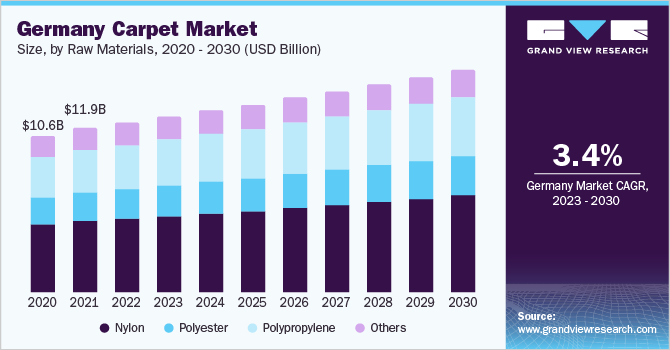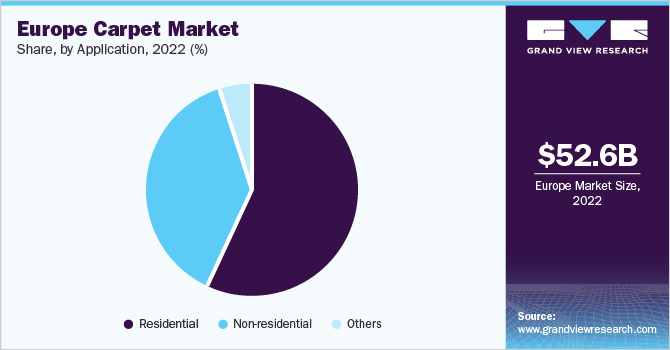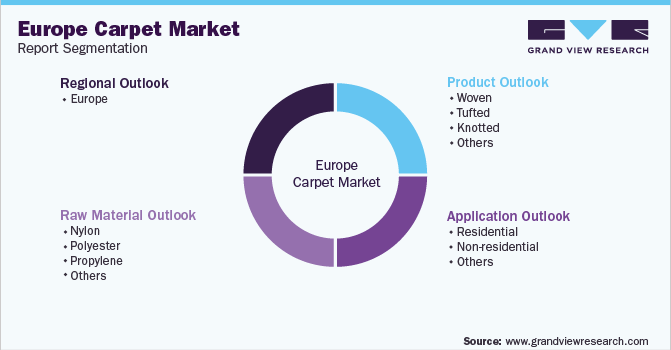- Home
- »
- Advanced Interior Materials
- »
-
Europe Carpet Market Size & Trends Analysis Report, 2030GVR Report cover
![Europe Carpet Market Size, Share & Trends Report]()
Europe Carpet Market Size, Share & Trends Analysis Report By Raw Material (Nylon, Polyester, Polypropylene, Others), By Product (Woven, Tufted, Knotted, Others), By Application, By Region, And Segment Forecasts, 2023 - 2030
- Report ID: 978-1-68038-775-9
- Number of Report Pages: 140
- Format: PDF, Horizon Databook
- Historical Range: 2018 - 2021
- Forecast Period: 2023 - 2030
- Industry: Advanced Materials
Report Overview
The Europe carpet market size was estimated at USD 52.60 billion in 2022 and is estimated to grow at a compounded annual growth rate (CAGR) of 4.3% over the forecast period. The market is anticipated to be driven by growing demand for tufted carpet in various applications including residential, non-residential and others in emerging economies such as Germany, U.K., France and Spain. Additionally, rising demand for residential building on account of high market visibility for soft flooring products and offering good insulation properties such as floor insulation is projected to positively influence the residential market.

The COVID-19 global outbreak severely impacted the trade relations of major players from several industries in Europe. The unexpected outbreak of the COVID-19 in 2020 had a significant impact on the European economy. As a result of the disease's high infectiousness, local governments were forced to impose lockdowns and restrict any movement.
Germany is projected to be the biggest contributor to the total market share. Significant improvements in infrastructures such as commercial offices, production sites, and residential buildings in Germany is anticipated to dominate the European market in the forecast period. Polyester is expected to increase at a fastener pace owing to the cost-effectiveness and ease of installation the trend has shifted from nylon to polyester. These are extensively used in commercial offices, residential buildings and among others.
Residential construction is presumed to observe a strong growth fueled by rising per capita income, low-interest rates, and a rising number of immigrants. The growing number of immigrants in Germany is driving the demand for new housing colonies. An increasing demand contributes to the price pressure in the housing sector, especially in metro cities, making it difficult for the lower and middle-class population to afford house. The government introduced the Housing Construction Campaign in an attempt to deal with rising prices and a shortage of housing. This is expected to aid the growth over the forecast period.
The products manufactured by the companies are sold in the domestic and international markets through various distribution channels including direct supply agreements and third-party vendors, who not only procure the products from the manufacturers but also distribute them across the globe through an extensive product distribution network. The vendors supply the products to several industries including textile, automotive, and military supply.
Mohawk Industries, Brinton’s carpet, Tarkett SAS, Radici Pietro Industries, and Balta group are the leading providers of carpet in Europe. These companies are predicted to account for substantial manufacturing and sale of the product owing to the high visibility of the volume of production. Various companies including Toray Group, Reliance Industries, W. Barnet GmbH & Co.KG, BASF, Arkema, and Braskem are the key players involved in the production of raw materials for the European carpet market. These companies’ products are produced through superior process efficiency to ensure high production and better-quality yield.
Raw Material Insights
Nylon emerged as the largest raw material segment in the Europe carpet market in 2022 and is estimated to maintain dominance with a CAGR of 3.0% throughout the forecast period. Nylon was majorly used raw material for production throughout the forecasting period on account of exhibiting good soil resistance and excellent texture retention properties. Manufacturers use nylon in the form of nylon-6 and nylon-66 for the production of finished goods.
Polyester carpets in Europe are expected to grow at a CAGR of 3.5% in terms of revenue in the forecast period. The most substantial development over the past few years has been the huge shift trend from nylon to polyester in the residential application pertaining to the low prices as compared to the other raw materials. The novel construction activities of big and small mills are now going further with polyester owing to the technological advancements which have made a massive shift from nylon to polyester.
Polypropylene carpets are projected to grow at a significant rate in terms of volume pertaining to the increase in the synthetic fiber and nonwoven industry, propylene carpet is projected to grow in the forecast period. These are usually bleach cleanable in the residential segments where pets and children often use floor areas. This is one of the significant factors for consumers to buy propylene carpets, thereby giving a distinctive benefit in terms of cleaning over the wool-based carpets.
Other raw materials such as polymer and polypropylene are anticipated to rise with the CAGR of 2.6% in terms of revenue in the near future on account of the rise in the demand for disposable income for carpets for beautiful interiors in a residential application. This is one of the major factor polymers is boosting the demands in decorative applications.
Product Insights
Woven carpets are considered to be one of the finest manufactured today and are being used for significant installations. Germany, Denmark, and U.K. are the largest importers of hand-woven carpets. In the emerging European market for woven carpets, there is still an opportunity for new suppliers. Numerous other developing countries witnessed high growth in terms of supplies to Europe. The robust performance of suppliers of woven carpets from emerging countries in the leading importing countries (Denmark, Germany and the United Kingdom) is also expected to increase in the forecast period.
Tufted carpet dominated the market in Europe in 2022 which accounted for a share of 49.52% and is expected to dominate the segment owing to the cost-effectiveness in a residential and commercial application. As of 2018, one-fifth carpets of the floor coverings used in the region are tufted carpets. These are used for wall to wall carpet flooring applications and are made up of a bunch of yarn fibers pierced through needle and cloth to produce a tufted look.
The knotted carpets product segment is anticipated to foresee the fastest growth in the near future owing to their high durability as compared to their counterparts. These provide comfort and softness and also enhances home interiors. Knotted carpets are considered to be a little expensive as compared to woven and tufted carpet owing to their costly production process. Also, their production process is long and arduous. Knotted carpets have finer details which are made up of better wool and involve more skilled tasks.
The others segment comprises carpet tiles, broadloom, and area rugs. While area rugs cover only a part of a room, carpet tiles are installed across the complete room or places such as lobbies and stairs. Broadlooms are carpet woven on a wide loom and can be used effectively in the domestic and commercial applications. The surging popularity of carpets offered in a variety of fiber systems offer consumers a more luxurious experience and provide retailers a chance to step up shoppers to a higher price point for achieving better margins.
Application Insights
Residential application dominated the market in Europe in 2022 which accounted for a share of 57.4% owing to the cost-effectiveness in a residential and commercial application. The demand for carpet in residential application is likely to exhibit a high growth on the account of growing housing completions at a rapid pace. Also, the growing trend for buying new carpets is high in the millennial population.
The demand for carpet in the non-residential application is projected to rise at a CAGR of 2.5% of revenue owing to the construction in the commercial, retail, institutional and office where carpets are widely used. The high dominance of strategic business units of pharmaceutical & chemical industries in the, U.K., Germany, and France are anticipated to increase the carpet demand as a flooring material in industrial units and commercial offices.

The non-residential construction segment is inclusive of buildings for hypermarkets, supermarkets, departmental stores, shopping malls, hospitals & clinics, restaurants & hotels, resorts, and others. Commercial constructions are generally large buildings or a cluster of buildings that carpet flooring materials are made from rigid and durable materials for protection against high footfall. An increase in spending on construction in the European economies are anticipated to support the demand in the forecast period.
Other applications including the automotive and aerospace industry in Europe is expected to grow at a strong pace. France is one of the leading players in the European aerospace industry. The French government has taken many initiatives to stimulate novel aerospace research and development programs in France to improve developments in the aerospace industry. Therefore, this is anticipated to upscale the demand in flooring applications.
Regional Insights
Germany accounted for the share of 23.60% in 2022 and is anticipated to ascend at a CAGR of 3.4% over the estimated period. The construction industry in Germany experienced a weak growth until 2015 owing to the economic slowdown due to the Eurozone crisis, which resulted in poor investor confidence and a decline in construction activities in the country. As a result, the market in Germany also experienced a major setback. However, the market in Europe is expected to witness moderate growth in the coming years with the gradual European economic recovery and improved business confidence.
U.K. is projected to grow significantly in terms of volume owing to the increase in the construction sector mainly in the property prices which showed stagnant growth. Also, U.K. has shown a robust increase in the automotive sector in the EU owing to the increase in the demand for vehicle manufacturing demand. The slow-paced growth of the construction sector in U.K. and also on account of the increasing property prices, the market is expected to witness a decline in demand for carpet in flooring applications in the forecast period.
The robust presence of automotive and chemical manufacturing facilities in France is expected to promote the use of carpets over the estimated time. Moreover, gains in the aerospace sector of Europe on account of rising government expenditure towards military aircraft are expected to play a crucial role in increasing Europe carpet market size over the forecast period.
Spain's carpet market is expected to witness huge growth on account of increasing housing sector output as a result of the rising number of new housing permits in Greater Madrid. The market in Europe is expected to witness a considerable growth in the coming years owing to the substantial surge in residential construction activities, driven by long-term investments in the sector. The rebound of the construction sector in the country owing to the economic recovery and an increased foreign investments, following years of severe recession is anticipated to boost construction activities in Spain, thereby fueling the demand for carpet floorings.
Key Companies & Market Share Insights
Owing to the fragmented nature and end-user opportunity of the market, the amount of rivalry is predicted to increase during the forecast period. Hence, the companies are majorly focusing on strengthening their market position in existing markets in Europe in developed regions, including North America and Europe, through attaining business assets of local players and creating novel technologies.
The industry is characterized by joint venture expansion, mergers and acquisitions, and a significant distribution to expand the market share of manufacturers. The industry is anticipated to witness growth with a rise in the demand for carpets through the residential and commercial sectors in Europe.
Companies have been heavily investing in R&D activities for manufacturing the product, resulting in dynamic market conditions. In recent times, there have been significant R&D activities focused on enhancing the products by players, such as Mohawk Industries and Balta Group, to have a stronghold in the industry.
Major players have a significant market share in terms of revenue, through domestic and international projects. The companies are involved in mergers & acquisitions to enhance their industry share. Some prominent players in the Europe Carpet market include:
-
Agnella S.A.
-
Balta Group N.V.
-
Mohawk Industries Inc.
-
Brinton’s Carpets
-
Creatuft NV
-
Associated Weavers International Group
-
Dekowe GmbH & Co.KG
-
Fletco Carpets A/S
-
Royal Carpet SA
-
Egetapper A/S
-
Teppichwerke GmbH
-
Radici Pietro Industries & Brands S.p.A.
-
Tarkett SA
-
MoquetasRols SA
-
Birko Birlesik Koyunlu’lular Mensucat Ticaret Ve Sanayi a.s. (Koyunlu AS)
-
Ruckstuhl AG
Europe Carpet Market Report Scope
Report Attribute
Details
Market size value in 2023
USD 55.26 billion
Revenue forecast in 2030
USD 73.89 billion
Growth Rate
CAGR of 4.3% from 2023 to 2030
Base year for estimation
2022
Historical data
2018 - 2021
Forecast period
2023 - 2030
Quantitative units
Volume in million square meters, revenue in USD million, and CAGR from 2023 to 2030
Report coverage
Revenue forecast, competitive landscape, growth factors, and trends
Segments covered
Raw material, product, application, region
Regional scope
Europe
Country scope
U.K.; Germany; France; Spain; ROE
Key companies profiled
Agnella S.A.; Balta Group N.V.; Mohawk Industries Inc.; Brinton’s Carpets
Customization scope
Free report customization (equivalent up to 8 analysts working days) with purchase. Addition or alteration to country, regional & segment scope.
Pricing and purchase options
Avail customized purchase options to meet your exact research needs. Explore purchase options
Europe Carpet Market Report Segmentation
This report forecasts revenue growth at regional & country levels and provides an analysis on the industry trends in each of the segments from 2018 to 2030. For this study, Grand View Research has segmented the Europe carpet market based on product, application, and region:

-
Raw Material Outlook (Volume, Million Square Meters; Revenue, USD Million, 2018 - 2030)
-
Nylon
-
Polyester
-
Propylene
-
Others
-
-
Product Outlook (Volume, Million Square Meters; Revenue, USD Million; 2018 - 2030)
-
Woven
-
Tufted
-
Knotted
-
Others
-
-
Application Outlook (Volume, Million Square Meters; Revenue, USD Million; 2018 - 2030)
-
Residential
-
Non-residential
-
Others
-
-
Regional Outlook (Volume, Million Square Meters; Revenue, USD Million; 2018 - 2030)
-
Europe
-
Germany
-
U.K.
-
France
-
Spain
-
Rest 0f Europe (ROE)
-
-
Frequently Asked Questions About This Report
b. The Europe carpet market size was estimated at USD 52.60 billion in 2022 and is expected to reach USD 55.26 billion in 2023.
b. The Europe carpet market is expected to grow at a compound annual growth rate a CAGR of 3.1% from 2023 to 2030 to reach USD 73.89 billion by 2030.
b. Germany dominated the Europe carpet market with a share of 23.6% in 2022. This is attributable with the increasing development in the transportation and construction industries, along with the rise in renovation activities.
b. Some of the key players operating in the Europe Carpet market include Agnella S.A., Balta Group N.V., Mohawk Industries Inc., and Brintonâ Carpets.
b. Key factors driving the Europe carpet market growth include the growing application of the product in residential and non-residential sectors on account of its high market visibility for soft flooring products and good insulation properties, such as floor insulation, is projected to positively influence the growth.
Share this report with your colleague or friend.
![gvr icn]()
NEED A CUSTOM REPORT?
We can customize every report - free of charge - including purchasing stand-alone sections or country-level reports, as well as offer affordable discounts for start-ups & universities. Contact us now
![Certified Icon]()
We are GDPR and CCPA compliant! Your transaction & personal information is safe and secure. For more details, please read our privacy policy.
We are committed towards customer satisfaction, and quality service.
"The quality of research they have done for us has been excellent."





